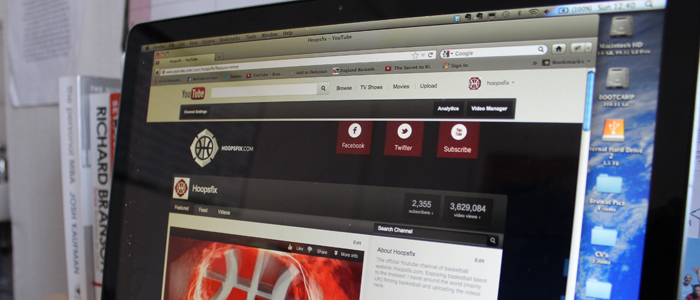 I turn 31 today, which still sounds ridiculous to me. It feels like yesterday I was 19 years old at university making all these big plans for my life. Time really does fly by. Continue reading
I turn 31 today, which still sounds ridiculous to me. It feels like yesterday I was 19 years old at university making all these big plans for my life. Time really does fly by. Continue reading
Author: Sam Neter
Straight From the Horse’s Mouth: 8 Tips from YouTube on How to Grow Your Audience
A few weeks ago I signed a contract to join YouTube network, Rightster. I’m intrigued to see how it goes, having always been a fierce believer in staying independent, but one of the immediate positive effects was being able to get an invitation to YouTube’s Sports Lab meet up.
There were around 50 plus sports channels from across the UK in attendance at the event, which took place at Google’s YouTube Partner space in central London. The day consisted of hands on video work, seeing around the space they have created for creators, and then workshops where their resident experts go through tips for us on how to improve and grow our channels.
Here are the 8 biggest take aways I got from the day, which was especially tailored to sports channels due to the different constraints they face. Whether it be from digital rights, access or resources, sports channels such as mine definitely do face a different set of challenges in comparison to any other type of channel.
1) You Must Upload Regularly
This seems pretty obvious and I’ve always known it, however, what I didn’t know was that if you do upload less frequently, the algorithm is automatically weighted to make your content less likely to appear in subscriber’s feeds when you do upload. I assume this is because people are subscribed to so many channels these days that it’s physically impossible to show every upload in people’s feeds (in similar fashion to Facebook choosing what to display and what not to display).
Additionally, they also strongly advised to have a strategy year-round; plan in advance for the off-season so you are continually pushing videos.
This definitely provided food for thought for me, especially as someone who doesn’t currently have scheduled programming and uploads on a sporadic basis.
2) Speed is of the Essence
YouTube said that around sports events specifically, you have around a 72 hour window to get something online. As everything moves more and more real-time (I get surprised if I search for a basketball highlight within 10 minutes of it happening and it’s not online), channels must adapt to this and ensure if they are covering specific events/competitions that their content is out their as quickly as possible.
I’ll never forget sprinting home in the pissing down rain back in 2010 after I’d filmed Kobe saying he would easily beat LeBron in a one on one, knowing that if I got it up first it had viral potential. It paid off – the video has now done over 2 million views and was all over US television over the next few days.
Contrastingly, I was also filming when Boris Johnson hit an over the head basketball trick shot last year. I got lazy, went for lunch, figured I would upload it that evening. The result? ITN got it online immediately, and broke the million views barrier, whilst mine hasn’t even broken 4,000 (yeah, I’ve embedded it below – every little helps!).
Speed is everything, especially when it comes to sports.
3) Use Google Trends to Find What People Are Searching For
A quick glance at Google Trends will show you what is being searched for the most, around the world, or in a specific country, right now.
Use this to your advantage – what content could you create based around this topic? An obvious example that comes to mind was ‘the Harlem Shake’ craze that started last year. A number of basketball teams jumped on this trend, and it resulted in a huge spike of traffic to their channels and long term growth of their audience.
There is also a YouTube Trends dashboard, though it’s definitely not as detailed as Google trends, it is worth a look every now and again. The YouTube Trends blogspot also has some interesting analysis sometimes.
4) Enable ContentID to Take Advantage of Fans Evangelizing Your Content
This was also something I’d never even thought about. On the rare occasions I’ve had videos that have gone “viral”, I’ve been very protect over those videos, and the moment I see people ripping it I’d flag it and report to YouTube to have it taken down.
What YouTube recommends in some cases, is just to monetize those videos on other people’s channels through Content ID. It means people can use your footage, edit it into compilations or whatever else, whilst you are the one getting paid for those views.
5) Collaboration is Incredibly Important & Easier Than You Think
One of the main purposes of the day was to network with other channels and try to come up with potential collaborations. I’ve long known YouTube believes collaborations is one of the best ways of growing your audience, however, have always struggled with that concept if you are a sports channel with no real “personality” as a front.
If you are a video blogger collaborations are easy, right? You just go and film a video with another channel and both sit their and talk. If you’re a sports channel that shows highlights however, it is a little more tricky.
Interestingly though, it is possible. They recommended using talent from each respective sport (if it’s a cross sport collaboration) to do different sporting challenges.
For example, one of the things we spoke about in our group was me getting a GB basketball player, like a Luol Deng or Pops Mensah-Bonsu, and getting them to team up with some professional footballers for trick shots. It could be cross-pollinated across both channels.
6) Have a Personality
Further to the comment in number five about not having a ‘personality’ to host your videos – YouTube’s recommendation is plain and simple; if you don’t have one, get one.
They couldn’t emphasise this point enough. Highlights and whatever else are great, but what really grows an audience is a personality that people can connect with and become a fan of.
I started this last year with my Hoopsfix Vlog channel, despite me being incredibly uncomfortable being in front of the camera, I recognise how important it is for the growth of my business.
7) Ask Yourself These 10 Questions Before Every Upload
YouTube gave us a checklist of ten questions to ask ourself about every video or show we create, which I will definitely bear in mind for future content.
They are as follows;
-Is it shareable?
Exactly as you’d imagine – will people want to share this with their friends after they watch it?
-Is it conversational?
Is there an element to your video that encourages conversation by directly addressing your audience?
-Is it interactive?
Is there a way to involve the audience in how the show is created, for example, replying to comments via video.
-Is it consistent?
Do you have strong recurring elements, or more importantly, a schedule – will people know when you are uploading?
-Is it targeted?
Have you thought about who your audience is for this particular video and how you can make it even more specific to them?
-Is it sustainable?
If the audience does love it, can you create more of it? Try not to be a one hit wonder.
-Is is discoverable?
Is it relevant to current affairs, will it come up in common and trending searches?
-Is it accessible?
If a new viewer watches your video, will they instantly get it, or do they need prior videos for context? Make it be able to stand alone.
-Is it collaborate-able?
Can you feature guests and collaborate with other channels on a regular basis?
-Is it authentic?
Are you being true to your brand?
8) Use Tent Pole Programming
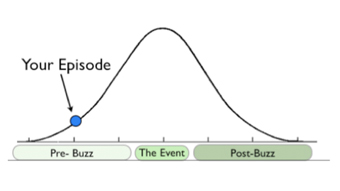 I pointed to this as a bonus tip in my post on how to increase YouTube views and still haven’t used it to maximum advantage.
I pointed to this as a bonus tip in my post on how to increase YouTube views and still haven’t used it to maximum advantage.
As I said then, this is where you align your content strategy with big events which are scheduled in the future. You release your video ahead of the event (see image), creating pre-buzz and helping to rank for the term you know will be searched a lot after (or as) the event has happened.
This is really relevant to sports channels as there are so many marquee events in every sport that dot the calendar year round. YouTube recommends to build a programming schedule that capitalises on the events that people want to see.
For me, that would include all the England and GB Junior National team events that are happening this summer; I could do preview videos of the teams, for example.
—
So those are my lessons learned – please let me know in the comments if you have any other examples or tips that you’ve seen work particularly well with sports channels.
As always – check out the YouTube playbook for more tips, it is FULL of great ideas.
2013 – Year in Review & The 7 Things That Have Changed My Life
It’s 8:49pm on Tuesday 31st December 2013 as I begin to write this, having just zero’d both my inboxes for the first time in *months*, to ensure I begin 2014 the way I want to continue.
Perhaps I should be out partying. Some of my closest friends being away has made it easier to make “having a chilled night in,” as my response to the numerous people who have asked what my plans are for this evening over the past few days.
It has definitely made me feel uncomfortable, maybe even a little embarrassed.
However, I think 2013 has been the biggest ever year for me from a personal growth standpoint. A huge part of that has been doing things that make me feel uncomfortable and that, traditionally, a younger me might never have done.
Don’t get me wrong, I still have a long way to go to get away from playing it safe all the time, but steps in the right direction have been made.
Taking time to sit down and reflect on the past 12 months is something that was important for me to make time for, and I’m happy to be spending my New Years Eve doing exactly that.
It has been a whirlwind year; Hoopsfix has continued to grow, the month of May marked 1 year since I quit my job to go full time on my own endeavours, financially things really perked up towards the end of the year (though still far from where I want to be), I got to travel (Spain, France, Italy, and the US), build new relationships, grow existing relationships, and my health has been the best it has been in years.
By far, the biggest thing that has impacted my year is having a morning routine. Seven things I now do religiously every single day set me up for the perfectly for what is ahead, and I now wonder how I ever survived without them.
These seven things are as follows;
1) Getting Up Early
I used to get up early, I was always a morning person when I was at school, college and university. At one point, when deep in my training, I would get up at 5am, eat, go back to sleep, then up at 6 to head straight to the gym.
Since graduating however, this work ethic somehow left me. Don’t get me wrong, I would still wake up at 7/8 everyday, but there was part of me that felt I was missing something.
I made the decision to start rising at 5am. Easily the best decision I have made in a long time. There’s something about the early morning; peace, serenity, and the ability to get things done without distraction whilst the rest of the world sleeps.
By the time it gets to 8-9am every day, I have now done what would normally have taken me the end of the day!
2) Meditation
Growing up I never understood meditation – it was just one of those things hippies, like my dad, did. I had no interest in it whatsoever.
However, this year it kept on cropping up; a lot of the entrepreneurs I follow were advocating it, so I figured what was there to lose?
I began with just five minutes (I was amazed at how hard it was to try to remain thoughtless and still for such a short period of time!), and now meditate for at least 15 minutes everyday.
It has led to me feeling clear-headed to begin the day, giving me greater clarity of thought during the day, and also made me far more self-aware.
3) Having Gratitude
Taking anywhere from 1 minute to 10 minutes a day to reflect on all the things I have in my life to be grateful for has been a huge game changer for me.
You know how hard it is to feel shitty about anything when you’re acutely aware of everything that you have to be thankful for?
I have a list of things that I’m grateful for pinned on my wall that I will read every day as a bare minimum for my gratitude practice.
Ranging from having fresh air to breathe, to being able to do what I love everyday, it makes you realise just how great it is to be alive.
4) Exercise
I began running at the start of this year, then in November started weight training again, and just a month or so ago, began doing yoga.
All three have made me feel great and no doubt led to greater productivity.
5) Reading
Reading and podcasts (see below) have been a game-changer for me this year. I’ve always read, but been very blase and un-regimented about it.
I have started reading for a minimum of 1 hour every day. It means I can get through at least a book a week, and am expanding my knowledge/learning constantly.
I invested in a Kindle, and now, when I see a book I want to read I immediately buy it straight on there so I have a growing library and never run out of things to read.
6) Podcasts
In similar fashion to meditating, a few years ago I just didn’t get podcasts. It wasn’t something that appealed to me, at all.
I don’t even know what inspired me to check ’em out, but now I will listen to at least half an hour of podcasts every day. They are constantly expanding my knowledge, and teaching me things I can apply to my every day life.
My favourites include Mixergy, Starting from Nothing, London Real, Silicon Real, Bulletproof Executive Radio, Foundation, and The Fizzle Show.
I will listen to them everyday whilst I am…
7) Cooking
Pre-preparing all my meals for the day has been amazing to ensure I am always getting the proper nutrition my body needs to perform optimally.
I’ll spend half an hour to 40 minutes making my food (whilst listening to a podcast!), putting it in tupperware ready for the day.
It means I never end up eating crap if I go out and about, and can stick to my training regime.
—
I am looking forward to the coming year, with a number of exciting projects in the pipeline, and one of the things I am determined to do is to update this blog on a much more frequent basis so that I can track my journey whilst also use it as a tool to hold myself accountable.
Let’s see what happens…
5 Tips for Using Social Media from Digital Basketball Experts
Over the past year or so I’ve been lucky enough to be able to secure interviews with some of the brightest digital media minds in the hoops world on how they use social media to grow their basketball brands.
Their experience and advice has been put together in the e-book “Basketball & Social Media” but below I’ve collated 5 of their top tips for you to be able to go and use right away!
1) Treat It as A National TV Interview
Peter Robert Casey, most well known for being the first media credentialed blogger in basketball history, says that whether you’re a coach, athlete or staff member, you need to recognise that everything you say is being broadcast to the world.
Act in the heat of the moment, and your followers are ready to screencap anything they know will be deleted when you’re in a more reflective mood!
“Treat social media the same way you’d handle a national television interview,” Casey says. “If you wouldn’t say it during a national television interview, don’t say it on social media. Period.”
If you’re at the helm of a basketball team or organisation, be prepared to provide a policy or guidelines for your team.
“Unless the policy is no social media at all, the training element is absolutely necessary,” he continued. “The words and actions of players, coaches and staff are always a representation of their team and organisation.”
2) Read and React
It isn’t always best to hop straight onto the newest social media fad believes Craig Miller, the media chief for USA Basketball.
“The important thing is not necessarily being first,” he began. “But being proactive and being able to quickly and effectively integrate whatever is next into your communication efforts.”
Be aware of new platforms appearing, (the most recent example being Vine) but don’t jump straight on it for the sake of being on there. Work out the benefit and craft a strategy.
3) How Can You Make Your Business Inherently More Social?
It’s extremely easy to get caught up in the online world and forget that you’re trying to run an offline business. The key is integrating the two so they complement and benefit each other
The NBA’s VP of Marketing, Melissa Rosenthal-Brenner, spoke about how the league changes their use of social media during marquee events such as NBA All Star Weekend.
“Everything gets “plus-ed” up, for lack of a better term,” she said. “We’re constantly examining how we could do things better and, whether it’s voting for the MVP or voting for the slam dunk winner, how do you inherently make them more social.”
Rosenthal-Brenner went on to say the NBA regularly looks at their existing business and tries to figure out ways to add more social elements to it.
Whether it’s fan voting, question and answer sessions or something else, ask how can you make the experience more social and help fans connect with not only your organisation but also one another.
4) Take the Good with the Bad
One of the things that came up regularly with our digital basketball experts was the fear a lot of organisations have of using social media because of the potential for negative feedback.
Nicolas Chapart is the world governing body’s Head of Digital, and says they have found an open approach is best.
“One can’t really control what people will say about FIBA, even if they happen to say something negative about FIBA we won’t delete the comment,” he said, unless it is vulgar or racist. “Depending on the attack, we reply and it usually works quite well. Users are positively surprised to get an answer from FIBA and that very often helps to cool down the situation.
“We are quite open on comments, there is very few that we ban. People are free to express their views as long as it is not racist or does not attack other individuals, players and/or coaches.”
Whether or not your organisation is active on a platform, the conversations will be happening anyway; you may as well have a hand in crafting those conversations.
5) Measure Your Bottom Line
Remember why you are using social media in the first place. Are you trying to increase ticket sales? Produce a response to a specific call to action?
David Astramskas, who has worked on social media campaigns with everyone in the basketball world ranging from NBA athletes to Ballislife and Team Flight Brothers, says setting goals is crucial for success.
“The only way to have any type of success with social media is to make reasonable goals. If I can’t create realistic ones on a project then I’m just setting myself up to fail.
“If I was just interested in getting a certain number of votes on a poll, clicks on a banner or views on a video that pays out because of volume, then high volume is my goal.
“If I’m trying to sell a product, “likes” don’t equal purchases and I rather have 10 likes that turn into 10 sales than 100,000 likes and 1 sale. The only way to get those sales is to capitalise off your fans no matter how big or small that number is.”
Astramskas summed it up by saying:
“Yes, it looks awesome to say look at these massive numbers but it looks more awesome to look into a private bank account and see massive numbers.”
Always make sure you’re actions are in line with your goals.
How are you promoting your basketball organisation using social media? Let me know in the comments.
You can download all the interviews in the Basketball & Social Media e-book here.
How I Increased My YouTube Views by 74% in 30 Days
YouTube has always been a big part of what I do with Hoopsfix. Everything online is becoming more and more visual, and the majority of my most viewed content on the site has always been video based.
Back in May, I was excited to receive an invite to the Google offices in London for a YouTube Partner Meet-Up. This session in particular was aimed solely at YouTube sports partners and intended to help us with everything from building a successful presence on the platform, to production tips.
After 3+ hours in the offices, a number of different presentations/speakers, and some great food, I headed home, mind buzzing with all the things I had just learned and excited to put them into action.
The results? Over the course of the next 30 days, pretty much every single metric that is measured in YouTube analytics went up, including a video view increase of 74% on the month before, and my subscribers net change increasing 55%.
Here is a screenshot of my analytics for the month of April (pre-meet up)
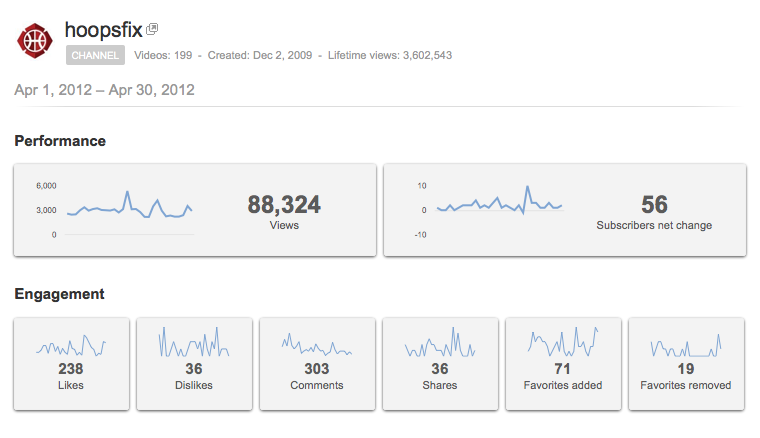
And here are the same metrics for May (post-meet up)
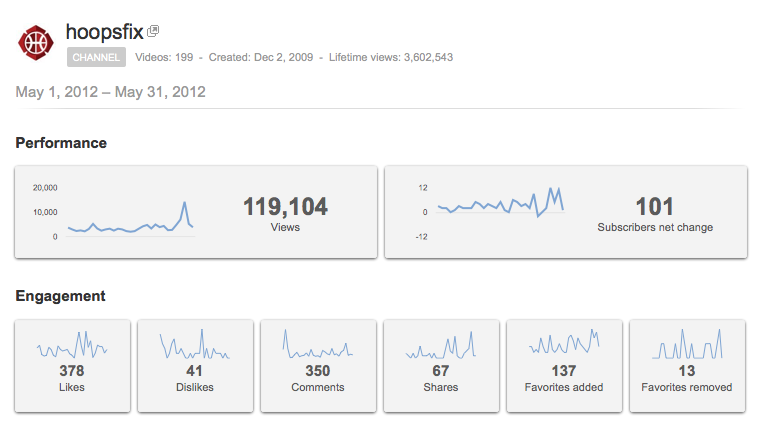
Of course, a number of external factors played a role (there was one video that did particularly well during the next month and ended up being aired on ESPN), but even removing that from the equation, everything remained markedly up.
To break it down even further, from January 1st 2012, until April 30th 2012 (121 days) the channel received 367, 003 views for an average of 3,033 views per day. From May 1st 2012 until September 4th 2012 (127 days) it has received 590, 817 views for an average of 4,652.1 views per day .
Check it out in the below image which shows total YouTube views for the year so far – the arrow marks the date of the optimisations.
 I have no doubt that the single biggest reason my YouTube views have increased so much is because of the strategies and best practices I was taught that day.
I have no doubt that the single biggest reason my YouTube views have increased so much is because of the strategies and best practices I was taught that day.
So what did I do?
1) Annotations
YouTube annotations – the (sometimes annoying) little messages that appear overlaid on videos – are a way to add interactive commentary and calls to action on your content. You can use annotations to add background information about a video, create a story with multiple possibilities (viewers click to choose the next scene and get taken to a different video), link to related YouTube content, and encourage interactivity (e.g. “thumbs up for the flying dog” encouraging people to like your video).
With Hoopsfix, I was using annotations before, but since they are relatively new, I had over a hundred older videos that were released before annotations even existed! I went back through all my older videos (it turned out that the majority of my most viewed videos weren’t annotated) and added annotations. I primarily used annotations to encourage viewers to subscribe, and view other related videos from my channel as the video was coming to an end.
2) Metadata
Don’t get it twisted, it’s boring and time consuming, but meta-data is so important! Metadata, loosely defined as ‘data about data’, in YouTube’s case, refers to your video title, description and key words.
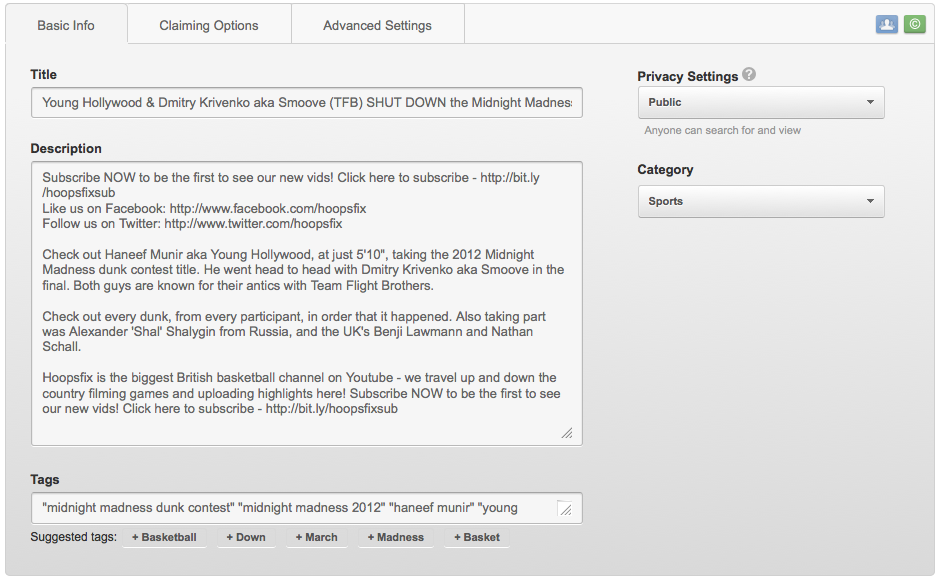 Essentially, you need to think about the type of terms people will be typing into search engines who will want to find your content.
Essentially, you need to think about the type of terms people will be typing into search engines who will want to find your content.
Specific to my channel, that is normally player’s names, the event name, and other broader basketball terms. I had older videos from a UK summer event called Midnight Madness, originally just named “Midnight Madness Bristol 2009” – I edited and included some of the more prominent player’s featured in the video, wrote more in depth descriptions, and filled the keyword box with every potential keyword I could think of. Google recommended starting specific, then going more broad. For example, event name, players name, england basketball, british basketball, basketball.
Two useful tools to help with keywords to use are the Google Adwords Keyword Tool and YouTube Keyword Tool. Type in the terms you are looking for, and not only see how much they are searched, but also other good suggestions. Use these to influence your video title decision, include them in the description and of course in the keywords.
3) Custom Thumbnails
Ever seen those videos which have a great pair of breasts as the thumbnail – you click through (along with the other 3 million people) to investigate, only to find out you’ve been gamed and the content is actually nothing to do with boobs? That right there is the proof the impact a good custom thumbnail can have!
We were recommended to get a close up shot that accurately depicts what the content shows. Below, to the right, you can see the thumbnail that I originally had on a video of Luol Deng, which I have since optimized to the one on the left, using a photo of him I have permission to use.
I choose to also overlay text with my website URL on – this is more a branding exercise than anything, a lot of my videos get embedded on other websites so it’s just a way of viewers seeing the source of the video.
 From June 22nd 2011 to April 30th 2012, this video had done 5016 views. Since May 1st (date of optimization) until September 4th 2012 (when I am writing this) it has done 6594.
From June 22nd 2011 to April 30th 2012, this video had done 5016 views. Since May 1st (date of optimization) until September 4th 2012 (when I am writing this) it has done 6594.
4) End Cards
End cards must be done during the production phase of your video, they need to be edited in to your video file at the end of the content, and then made ‘clickable’ by using ‘Spotlight’ annotations. In the above picture you can see the type of end card I use in my videos (hat tip to Hoopmixtape for that).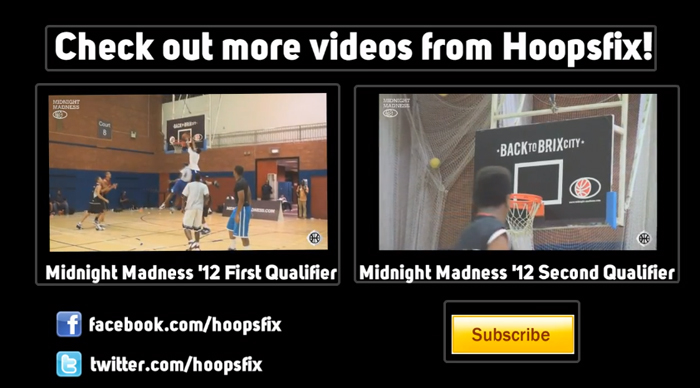 YouTube only allows you to link to other YouTube content, so the Facebook & Twitter links, I just added in for people to see the URL and type into their browser should they so wish.
YouTube only allows you to link to other YouTube content, so the Facebook & Twitter links, I just added in for people to see the URL and type into their browser should they so wish.
Though I used end cards before the meet-up, I didn’t do it on every video. Now, without fail, every single video I upload to Hoopsfix has an end card. Recently YouTube analytics have began to show the click through rates on my different annotations, and it’s not even close – the annotations on my end card have a far higher CTR than any others I place elsewhere during the video (which personally, I find distracting and turn off).
4) Video Upload Frequency
Sounds simple, but uploading regularly makes a huge difference to the community you can build. Prior to the Meet Up, I was uploading sporadically, whenever I had time to edit some stuff. I wasn’t making a conceited effort to publish regularly.
Over the course of the next 30 days, I uploaded 12 videos (compared to 6 the month before, it was easily the most I’d ever done), doubling my output from the month before. The nature of my channel makes it a little more difficult to keep a schedule (it depends largely on events going on), however, if you are a vlogger, or a cooking show for example, have a schedule and keep to it. The Google heads couldn’t emphasise this enough – if you tell people you are releasing a new episode every Tuesday, if will do wonders for your channel activity.
5) Playlists
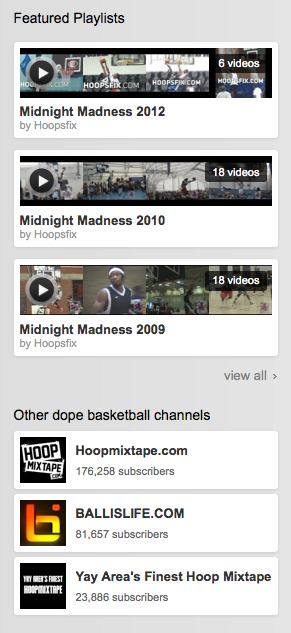 Ever searched something on YouTube and in amongst the results you see a playlist?
Ever searched something on YouTube and in amongst the results you see a playlist?
This happened to me many times, and rather than thinking about how I could use this to my channel’s advantage, it took the lovely people at Google to point it out to me. In my case, sometimes I have produced a few different videos from one event, so by batching them together into a playlist for that particular event, it has helped drive traffic by ranking for the name of that event.
It also increases a viewers’ watch session by automatically playing the next video in the playlist. You have the option to embed your video within the playlist as well, so if you drive traffic to your channel from other sites it will increase views to other videos in the playlist as well.
7) ‘Other Channels’ on Homepage
YouTube wants you to be involved with the community, and that involves working with other content creators (channels). They have a handy feature which allows you spotlight other channels of a similar nature on your own channel homepage.
My initial thought was, “but what, I’ll be driving people *away* from my channel!”, though this is true, it was explained that it will also help you in two ways.
- The idea is you cross promote with another channel so you both reach each other’s audiences (make sure it is someone with a similar sized audience -approaching a big dog with 100,000 subs, and asking to do a cross promotion with your 3 subscribers probably won’t work – unfortunately for me I’m the only real UK basketball YouTube channel, so I have no choice). Yes, you will drive people away from your channel, but the other content creator’s channel will drive new subscribers to you.
- YouTube’s recent changes in their algorithm mean ‘watch time’ has a huge effect on your rankings. Not only watch time on your own videos, but if you refer someone to another person’s channel, and their whole watching session increases – you will be credited and see a rise in your own rankings as a creator who is providing value to the community!
Obviously I can’t measure the impact that this has had, but it’s something I did that may have contributed, and regardless, helped others by pointing them to other relevant content they might be interested in.
Bonus Tip:
Tent-Pole Programming – one of the things that was spoken about that I haven’t had the chance to test out properly is ‘tent-pole programming’. This is where you align your content strategy big events which are scheduled in the future. You release your video ahead of the event, creating pre-buzz and helping to rank for the term you know will be searched a lot after the event has happened.
As an example, with the Olympics having just finished – a month before I should have produced an ‘London 2012 Olympic Basketball Preview’ video. I’m almost certain it would have driven a lot of views, but unfortunately I just didn’t have the time to source the footage and execute it!
Further Reading
If you are really interested in how to better market your channel, increase YouTube views and increase YouTube subscribers, definitely check these out:
YouTube’s Creator Playbook – this is simply a must have resource for anyone hoping to grow their YouTube presence, and it’s free! There is so much great, actionable advice in here, I refer to it on a weekly basis – it is the YouTuber’s bible!
Christopher Sharpe – Christopher is a director/producer/editor, and the man behind the camera for the reputable Hilah Cooking (YouTube Next Chef winner, 25,000 subscribers and counting). The advice he provides on his blog about YouTube, and their experiences with Hilah Cooking is some of the best I have read, in particular his 7 tips for increasing your YouTube views.
Chris Pirillo’s 50 YouTube Tips & Tricks – Chris, and his YouTube channel Lockergnome are now approaching 200k subscribers (!). When he surpassed 50k, he wrote this really useful blog post, with a lot of great tips in it.
So, that’s pretty much me done! If you are a YouTube partner, or even have a YouTube channel and have any other tips, please share them below! I’m always looking to learn, and wish more people would document behind the scenes stuff of their big YouTube channels!



